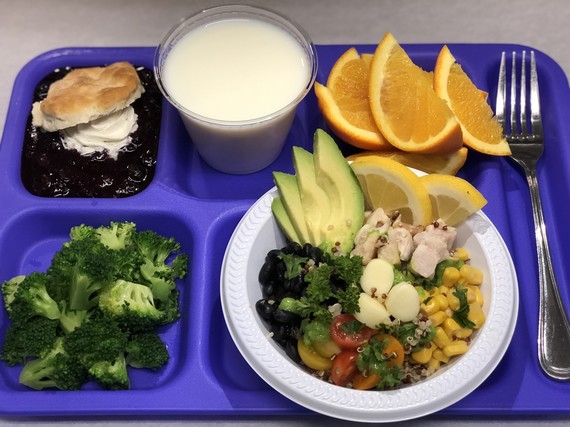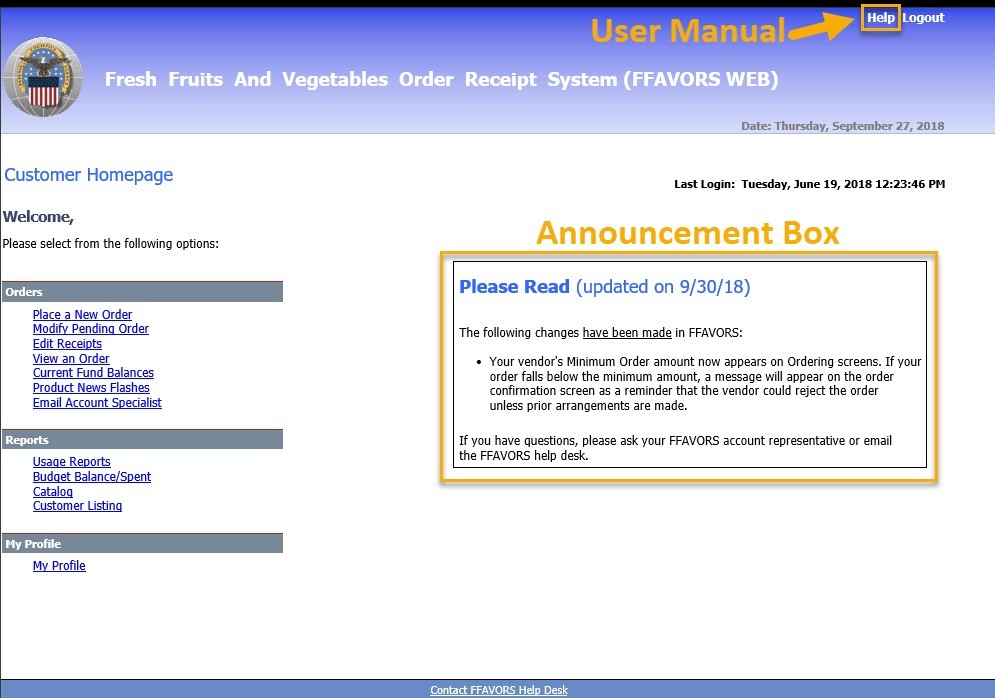Start the Day with USDA Foods
Starting the day with a nutritious breakfast leads to increased productivity, focus, and overall well-being, for students in the classroom. USDA Foods can be used to create healthy and delicious breakfast options that will fuel students to be their best. When ordering your next round of USDA Foods, States and school districts can consider these versatile options that can be used for breakfast, lunch and beyond:
|
|
|
|
|
High-Protein Yogurt
High-protein foods at breakfast help students feel full longer so they can focus during class. Individual yogurt cups are offered in vanilla, blueberry and strawberry flavors making this a quick and easy option that appeals to a wide audience.
|
Dried Fruit
Dried fruit can be used as a topping or in a yogurt parfait. It adds color and texture to keep breakfast fun. USDA Foods offers dried cherries, dried cranberries, raisins, or dried mixed fruit that contains a combination of apples, cherries, cranberries, and raisins. Dried cranberries and raisins are also available in individual package sizes which can make a great grab and go snack option for late arrivals.

Eggs
Eggs are another high protein option that are great in breakfast burritos, sandwiches, or served as-is topped with other USDA Foods like cheese or diced tomatoes for a southwestern twist. USDA Foods offers liquid whole frozen eggs and frozen egg patties. In addition, many school districts choose to purchase liquid whole eggs for processing through the National Processing Program into end products such as burritos.
|
You can’t go wrong with incorporating USDA Foods into your breakfast program or breakfast for lunch. All of the breakfast foods highlighted above are ordered on a quarterly basis, so there are many opportunities for States and school districts to get your orders in!

USDA Foods Support Sodium Reduction in School Meals
In June, USDA published the results of The Successful Approaches to Reduce Sodium in School Meals Study. More than half of the school districts in the study reported maximizing participation in USDA Foods and USDA Department of Defense (DoD) Fresh procurement programs as a primary strategy to reduce sodium in school meals. More than half of the school districts also reported effective menu planning practices including incorporating more fresh and/or frozen fruits and vegetables and other low sodium products into meals and changes to food preparation methods, including cooking with more herbs and spices and maintaining or increasing the use of scratch cooking.
USDA Foods options include a wide variety of frozen fruits and vegetables, including recent additions such as Individual Quick Frozen (IQF) pepper and onion blend, IQF sweet cherries, and smaller bags of a wide variety of frozen fruits and vegetables to promote batch cooking. More than 70% of direct delivered USDA Foods products include 5 ingredients or less, and USDA has been working for over 10 years to reduce sodium levels to at or below the industry standard in a variety of minimally processed foods such as canned vegetables and beans, cheese, frozen meat and poultry products, deli turkey and ham products, fish, and whole-grain rich items including pancakes and tortillas.
The USDA DoD Fresh program continues to offer school districts a wide variety of fresh fruit and vegetable products, including fresh-cut items, like apple slices, baby carrots and shredded lettuce. USDA continues to work closely with the DoD to improve other aspects of the program, including expanded coverage in many States, availability of local produce items in season, and requiring vendors to report where produce items are from under the State of Origin field in the FFAVORs catalog. USDA Foods have always been minimally processed and seasoned, to allow school districts to customize their USDA Foods to meet the diverse menu needs and flavor profiles that their students prefer.
We are pleased to see so many school districts reporting use of the USDA Foods program to support high quality, nutritious school meals. Keep up the good work!
|

Ground Beef
As the school bell rings, the aroma of school lunches fill the halls across schools in the United States. Ground beef, a staple of the National School Lunch Program (NSLP), is a versatile meat choice that can be served in many ways. Ground beef is an excellent source of protein, B vitamins, and iron.
USDA Foods offers frozen fine ground beef and beef patties, as well as cooked frozen beef crumbles for direct delivery. Ground beef for direct delivery is the most widely used USDA Foods protein item with an average of 48 States ordering this item each year.
In addition, frozen coarse ground beef is offered in bulk for further processing. On average, 41 States order bulk coarse ground beef through USDA Foods for processing through the National Processing Program, allowing schools to provide a variety of meal options such as taco meat, chili, soup, and meatballs on the school menu. Coarse ground beef is the fifth most widely used protein item in USDA Foods. In school year 2019, over 69,000,000 pounds were purchased, that is the size of more than 290 large blue whales!
|
Creative ways to use USDA Foods
It’s a new school year and the perfect time to switch things up with new menu items. If you are looking for creative ways to use your USDA Foods, you are not alone! The 2019 School Nutrition Association (SNA) and American Commodity Distribution Association (ACDA) conferences featured multiple sessions with school district panelists providing insight on how they use USDA Foods in a variety of creative, kid-friendly ways. Many state agencies have also developed recipe resources that feature USDA Foods items. For a little inspiration, check out these fantastic recipe collections developed by the North Carolina Department of Public Instruction, Mississippi Department of Education, and the Wisconsin Department of Public Instruction! Do you have a great USDA Foods recipe resource to share? Let us know by emailing USDAFoods@usda.gov.

Revised Policy Memo FD-064
On April 2, FNS released the revised policy memorandum FD-064 – Management of USDA Food Inventories at Processors. This memorandum revises the previous FD-064 (Revised), dated March 20, 2012.
Several revisions were made to clarify changes made by the Final Rule: Revisions and Clarifications in Requirements for the Processing of Donated Foods. FD-064 covers the monitoring of USDA Food inventories at processors and gives additional flexibility to the calculation of the six-month inventory limit at processors.
Other helpful topics include transfers of USDA Foods inventories and inventory requirements.

USDA DoD Fresh Fruit and Vegetable Program
States can choose to utilize their USDA Foods entitlement on the USDA Department of Defense (DoD) Fresh Fruit and Vegetable Program. Through this program, USDA has been able to offer school districts a variety of fresh produce, including pre-cut products, increased pack sizes, and consistent direct weekly deliveries of fruits and vegetables.
Vendors are encouraged to offer locally grown produce when in season and reasonably priced. States and schools that want to purchase local fruits and vegetables through USDA DoD Fresh should look for products marked with “Local” in the Fresh Fruit and Vegetable Order Receipt System (FFAVORS) catalog. DoD defines local produce as produce from within the state or adjacent states. It must meet contract requirements for quality and food safety and be priced competitively. If you want a specific local produce item, contact the vendor and your DoD representative and ask if the item is available and if it can be added to the catalog.
|

New State of Origin Reporting Requirement for USDA DoD Fresh
The DoD through the Defense Logistics Agency (DLA) manages the procurement contracts for produce vendors. All produce offered through this program must be grown in the United States. Over the years, States and SFAs have shared why it is important to know where produce comes from and FNS is excited to announce a new state of origin reporting requirement. Beginning October 1, 2019, vendors will be required to include the state where the product was grown.
Due to the different growing seasons vendors source produce from multiple suppliers across the country. To accommodate this variability, vendors can list up to three different states where the product is from. For example: a vendor in Maryland may source apples from New York, Pennsylvania, and Virginia. This vendor will list these three states under “State of Origin” in the FFAVORS catalog.
If the vendor does not include "State of Origin" information after October 1, this item will not be listed in the FFAVORS catalog, and no orders will be placed for this item. We have been working closely with DLA and the vendors in preparation for this new reporting requirement. We appreciate the efforts of vendors to comply and hope States and school districts appreciate having this additional origin information available in FFAVORS.
|
USDA DoD Fresh Program Complaint Process
We recommend that you inspect produce at the time of delivery and document on the delivery document any quality or condition issues, or product shortages. Reject any produce item that is not grown in the United States. It is essential that all issues regarding produce quality, condition, availability, and delivery are documented on the delivery document and include details and photos of the issue(s).
Report any issues with produce received through the USDA DoD Fresh Program to the appropriate DoD Service Representative, the vendor, and the State Distributing Agency (SDA). Make copies of this documentation and maintain it for your records. If issues are reported and not resolved, please contact USDADoDFresh@usda.gov. We welcome your feedback on the USDA DoD Fresh Program.
Refresher on FNS Instruction 709-5: Shipment and Receipt of USDA Foods
On September 5 FNS hosted a webinar that provided USDA FNS Regional Offices, State Agencies, Recipient Agencies, and warehouses a refresher on the FNS Instruction 709-5: Shipment and Receipt of USDA Foods.
The webinar highlighted the five key areas involved with the shipment and receipt of USDA Foods: arranging shipment and delivery, guidance on inspecting the shipment, accepting and receipting the shipment, unloading the shipment, and disposition and replacement of USDA Foods. In addition, E-invoicing in WBSCM and filing complaints was covered.
Watch a recording of the webinar here.
How to Use the New State Distributing Agency Monthly Performance Report Template
A standardized State Distributing Agency (SDA) Monthly Performance Report (MPR) template was developed to reflect the National MPR template. The new SDA MPR template is an excel file format, which allows the user to easily analyze, filter, and sort aggregate data to create personalized reports.
A webinar was held on August 15 where FNS discussed tips on how to use the new template. The webinar was recorded and a copy of the recording is available in the USDA Foods Processing PartnerWeb Community. For more information please email NPA@USDA.gov.
FFAVORS News and Help Resources
The next release for the Fresh Fruits and Vegetables Order/Receipt System (FFAVORS) will go live on September 30, 2019. Do you know how to stay informed about changes?
- When you log in, the welcome page displays a summary of the latest changes and helpful reminders in the announcement box. News is customized to include relevant information for each user group. For example, customers and vendors may see different highlights.
- The user manuals are also updated regularly to keep with the latest changes. To view or download a copy of the most recent manual for your user role, click the Help link on the menu bar in the upper right portion of the screen.
 Please contact the FFAVORS Help Desk at ffavors@usda.gov with any questions.
Clipboard Access for WBSCM
As a result of the Web-Based Supply Chain Management (WBSCM) system upgrade in September, WBSCM will not automatically have access to the clipboard when users are copying or pasting information into some fields. Depending on the browser settings, users may be prompted to manually grant permission to the clipboard.
 Users have two options:
- Adjust Internet Options settings for the IE browser to grant permission to the clipboard. Go to Security > Custom Level. Scroll down to the Scripting settings, and enable Allow Programmatic clipboard access (Changing this setting may require an administrator role and/or assistance from local technology support).
- Manually grant permission whenever prompted.
Please direct questions to the WBSCM Service Desk at wbscm.servicedesk@caci.com or call (877) 927-2648.
|